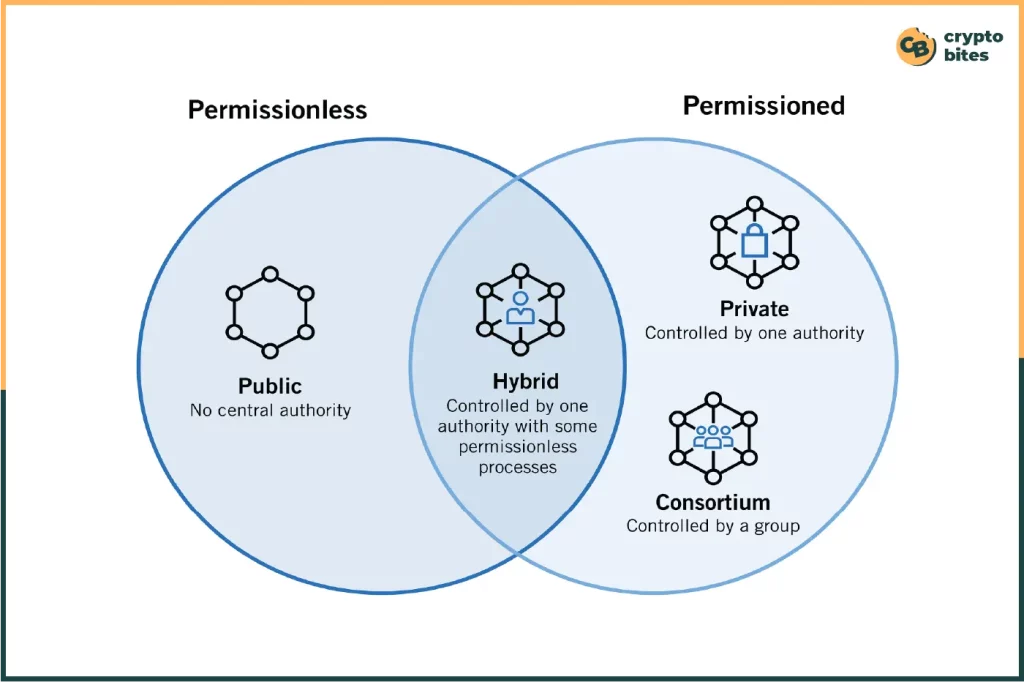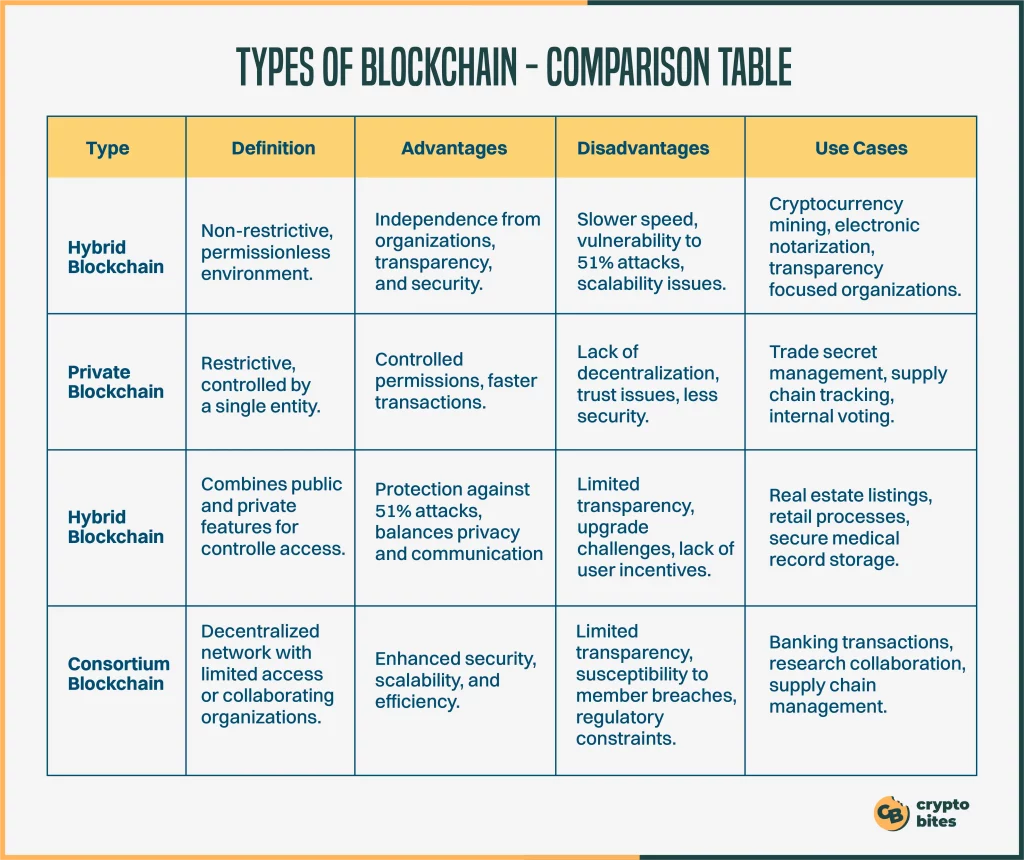
4 Types of Blockchain – Which One’s Better?
So, if your company’s jumping on the blockchain bandwagon, here’s the lowdown on what you gotta think about.
First off, you gotta figure out which type of blockchain is your best bet for the project.
Not sure about anything else, but nailing down the right kind is key.
Now, you’re probably like,
“What even are the types of blockchain?” and “Which one’s right for my project?”
Well, I got you covered.
In this guide, I’m gonna break down the different categories of blockchain and help you find the one that fits your company like a glove.
Let’s get straight to the POINT!
Permissionless Blockchain and Permissioned Blockchain
There are 4 types of blockchain: public, private, consortium and hybrid blockchain. All types of blockchains can be categorized into either permissionless or permissioned blockchain.
Permissionless Blockchain
A permissionless blockchain is an open and decentralized network where anyone can join without needing permission. It’s more secure with lots of participants (nodes), making it tough for bad actors to mess things up. However, due to the large crowd, transactions might take a bit longer to get through.
Permissioned Blockchain
A permissioned blockchain is a closed and controlled network where access is restricted to authorized nodes. Its efficiency comes from having fewer participants, resulting in quicker transaction processing compared to permissionless blockchains.
So, putting things into perspective: a permissionless blockchain is like a decentralized party where anyone can join without asking while a permissioned blockchain is more like a private club where only approved members (nodes) have access.
This exclusivity makes it more efficient, speeding up transaction processing because there are fewer participants in the network.
The advantage of reduced processing time in permissioned blockchains comes with a downside: their centralized nature makes them less secure. Centralization, where authority is vested in a government, company, or another entity granting permissions, exposes the system to traditional hacking vulnerabilities.
With fewer nodes, the risk of collusion by malicious actors increases. Therefore, administrators of private blockchains must prioritize trustworthiness among nodes contributing and validating blocks to mitigate security concerns.
Permissionless blockchains usually provide higher security, thanks to a multitude of nodes validating transactions, making it challenging for malicious collaboration.
However, the trade-off, as I mentioned earlier, involves longer transaction processing times due to the sheer number of nodes and the sizes of transactions.

4 Types of Blockchains Explained
Blockchains are of 4 types, namely public, private, consortium and hybrid blockchain. Now I’ll provide with a detailed breakdown of each type along with their benefits and limitations:
Types of Blockchain – Comparison Table

1. Public Blockchains
A public blockchain is a permissionless and fully decentralized network where anyone can participate. It provides equal access to all nodes, allowing them to create and validate blocks of data.
Typically associated with cryptocurrency exchange and mining, popular examples include Bitcoin, Ethereum, and Litecoin. In public blockchains, nodes, often referred to as miners, contribute by creating blocks through solving cryptographic equations for requested transactions.
In return, these miners earn a small amount of cryptocurrency, acting as modern-era bank tellers who process transactions and receive a fee for their efforts.
Benefits of Public Blockchains
- Public blockchains are open to everyone.
- Builds trust through transparent and unchangeable transactions, ensuring security and accountability.
- The decentralized nature encourages active user involvement for continuous improvement.
- Transactions don’t need intermediaries, reducing third-party involvement and costs.
- Depending on node engagement, public blockchains can be highly secure.
Limitations of Public Blockchains
- May have slower transactions during high network activity, affecting user experience.
- No ability to set access or usage limits, potentially causing privacy and control issues.
- Vulnerable to attacks if an entity controls 51% or more of computational power, allowing unilateral changes.
- More nodes may lead to scalability problems, reducing performance and causing congestion.
Public Blockchain Use Cases
Public blockchain is usually used in diverse fields, including areas that demand high-level data security and privacy, such as healthcare, finance, and government.
Public blockchains offer a transparent and secure platform to implement blockchain technology, ensuring integrity and trust in sensitive data transactions.
2. Private Blockchain
A private blockchain, also known as a managed blockchain, is a controlled and permissioned digital ledger operated by a single entity.
The central authority determines who can participate as a node, and not all nodes have equal rights for executing functions. While it lacks full decentralization, a private blockchain limits public access.
Examples include Corda, used for financial activities and software development, and Hyperledger, an umbrella project for open-source blockchain applications.
When compared to public blockchains, private ones validate new data more quickly but are more vulnerable to fraud.
To overcome these drawbacks, consortium and hybrid blockchains have emerged, combining elements from both private and public blockchain models.
Benefits of Private Blockchain
- Private blockchains operate faster because they have fewer users compared to public blockchains. This lower user count results in quicker transactions and faster consensus.
- The limited number of authorized nodes in a private blockchain facilitates better scalability by validating transactions more effectively.
Limitations of Private Blockchain
- One major drawback of private blockchains is that they undermine the core principles of blockchain and distributed ledger technology.
- Establishing trust within a private blockchain is challenging as centralized nodes hold the final decision-making authority.
- The security in private blockchain is constrained due to the smaller number of nodes.
Private Blockchain Use Cases
Private blockchains are pivotal in the development of Central Bank Digital Currencies (CBDCs), providing a secure foundation for digital representations of fiat currencies.
In shipping, they cut down on errors and amp up distribution speed.
For organizations, private blockchains offer a peek into supply chains, reducing waste and keeping sensitive data under wraps.
Logistics giants like DHL use them to track shipments, ensuring smooth transactions and quick collaboration.
In industries like retail, healthcare, insurance, finance, and government, private blockchains provide secure, and scalable databases tailored to specific needs.
3. Consortium Blockchain
A consortium blockchain is a type of permissioned blockchain managed by a group of organizations, rather than being under the control of a single corporation as seen in private blockchains.
Consortium blockchains offer a higher degree of decentralization compared to private blockchains, resulting in enhanced security.
However, establishing consortiums can be challenging, requiring collaboration among multiple organizations and presenting logistical and potential antitrust risks.
Notable examples of consortium blockchains include solutions from R3 for the financial services industry and CargoSmart’s Global Shipping Business Network collaboration.
These initiatives aim to digitize industries like finance and shipping, fostering more effective collaboration among industry operators.
Benefits of Consortium Blockchain
- Consortium-built blockchains are highly scalable and secure.
- More efficient compared to public blockchain networks.
- Includes clear governance frameworks.
Limitations of Consortium Blockchain
- Despite network security, vulnerability arises from the integrity of its members.
- Limited transparency.
- The effectiveness of the network is significantly impacted by laws and censorship.
Consortium Blockchain Use Cases
Consortium blockchains, like those used in healthcare networks, enable multiple organizations to collaborate securely.
They provide a shared platform for managing patient data, ensuring privacy, and improving interoperability among healthcare providers.
Apart from healthcare, you can also use consortium blockchain for Government and Cybersecurity related operations.
4. Hybrid Blockchain
A hybrid blockchain is a type of blockchain controlled by a single entity but incorporates a level of oversight from the public blockchain for validating specific transactions.
An example is the IBM Food Trust, designed to enhance efficiency in the entire food supply chain.
This hybrid approach combines the control of a private blockchain with the transparency and validation mechanisms of a public blockchain, ensuring a balance between centralized control and decentralized verification.
Benefits of Hybrid Blockchain
- Operates within a closed ecosystem without the need to disclose everything publicly.
- Rules can be adjusted based on circumstances.
- Protects privacy while being part of a public network.
Limitations of Hybrid Blockchain
- Lack of clarity.
- Transitioning to hybrid blockchains can be challenging.
- Absence of incentives for joining the network and participating.
Hybrid Blockchain Use Cases
Hybrid blockchains, offering the best of both public and private models, find ideal use cases in healthcare data management and financial services transactions.
In healthcare, they balance transparency and privacy to securely manage patient records.
In financial services, hybrid blockchains enable secure and transparent transactions, supporting efficient cross-border payments, smart contract execution, and auditing while safeguarding sensitive financial data.
Which One Will You Go For?
In wrapping up, the various forms of blockchain present unique opportunities tailored to your specific needs.
If you’re a business prioritizing confidentiality, the private blockchain is a solid choice.
On the other hand, if transparency is your goal, exploring a public platform is worth considering, though bear in mind its limitations for enterprise applications.
As you’re trying to figure out, don’t forget to match your choice with unique requirements and objectives that matter most to you or your organization.




